|

Belts,
Girdles & Belt Fittings
STYLES OF BELTS & GIRDLES - BELT MATERIALS
- BUCKLES - MOUNTINGS - BELT HANGERS
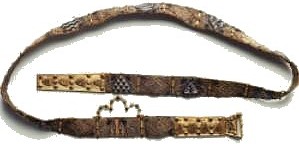 A
medieval woman's belt was usually known as a girdle. A woman's
wealth and status was, as usual, displayed in the costliness of
dress and accompanying accessories. Belts, whether made from leather,
metal or embroidered fabric were often as lavish as possible. A
medieval woman's belt was usually known as a girdle. A woman's
wealth and status was, as usual, displayed in the costliness of
dress and accompanying accessories. Belts, whether made from leather,
metal or embroidered fabric were often as lavish as possible.
As with most forms of dress accessory, belts also came under fire
for ostentatious decoration. Preachers and clergymen found yet
another source of criticism for the vanity of woman. A 13th century
preacher from Paris, Gilles d'Orlean, rebuked women for their
affluence of dress and accessories chiding:
that Jesus Christ and
his blessd mother, of royal blood though they were, never thought
of wearing the belts of silk, gold and silver fashionable among
wealthy women.
Some women were employed
in the production of decorative girdles, but not many. In 1344,
the Guild of London Girdlers regulated the employment of women
in their ranks to:
their wives and daughters
only and no independent women.

Styles
of belts & girdles
The shape of the belt most commonly worn in the middle ages was
long and thin. The girdle was worn low on the hips with a knot
at the buckle and the remaining tongue hung down the front.
The pendant tag at the belt
end is known as a belt-chape. It is shown as the round
knob at the bottom tip of the belt seen here above at right. This
existent belt chape from London in the 14th century.
Many had decorative buckles
and additional metal mountings which were often sewn on, and most
had a metal chape at the end. The higher up in society a woman
was, the more likely it was that her girdle would be ornate with
much in the way of ornamentation.

Belt
materials
Belts were made of one of four materials- leather, woven braid,
embroidered fabric or solid metalwork. Peasant women wore sturdier
and more practical belts of leather or belts made from woven wool.
Almost all of these would have been unadorned except for the buckle.
 Women
of better financial standing or breeding wore thinner girdles
of better processed leather or embroidered girdles or woven belts
of silk with more elaborate metal clasps or buckles. Where leather
girdles were concerned, designs were also painted or stamped onto
the belt leather directly. Women
of better financial standing or breeding wore thinner girdles
of better processed leather or embroidered girdles or woven belts
of silk with more elaborate metal clasps or buckles. Where leather
girdles were concerned, designs were also painted or stamped onto
the belt leather directly.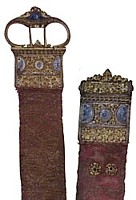
The belt at left is an example of beautiful needlework and is
known as the Branco Belt. It is believed to be from the 14th century.
It features a design similar to that of illuminated manuscripts
with flowers bordering windows with birds and mystical animals.
Shown at right is a 15th
century belt made from cloth of gold with an ornate buckle set
with enamel and jewels. It is Italian made and dates to 1450.
The two-pronged tongue was popular on buckles towards the later
end of the medieval period
Margherita Datini, an Italian
medieval woman of means, listed two leather belts in her personal
inventory of 1397, a blue one and a black one, both with silver-gilt
buckles. She preferred the heavier belts to the lighter ones currently
in fashion and gained a terse reply from her husband to her wishes
to return one such belt:
if Margherita wanted
to wear what the peasant women wore, then all right.
Aristocrats and women of
the high medieval court also wore heavy, jeweled, metal belts
and silk girdles with gold embroidery, enamels, precious stones
and metals set into them.
When Johnna, the daughter
of King Edward I, married Gilbert de Clare, it was recorded that
she wore a magnificent girdle of gold with rubies and emeralds
which was bought in Paris for the huge amount of 37 pounds and
12 shillings. At Queen Jeanne of Burgundy's coronation in 1317,
she was given four belts embroidered with pearls.
In 1319, Mahaut is recorded
as giving a gift to his niece of a silk belt trimmed with gilded
silver.
A 1305 record from a mercery
in Paris records a green silk belt with rosettes of pearls and
gold.

Buckles
& buckle plates
Medieval belt buckles ranged from the simply functional to the
beautiful and elaborate. Belt buckles of this time period featured
the chape, an oblong case of metal to which the girdle was affixed.
Many were of solid construction, although some finds have shown
buckles with a roller. Pewter, lead and tin buckles were not common
before the 14th century.
 The
London Girdlers Guild Charter of 1321 sanctioned only latten,
copper, iron and steel as suitable buckle-making materials. Cheaper
white-metal alloys proved to be popular regardless. The
London Girdlers Guild Charter of 1321 sanctioned only latten,
copper, iron and steel as suitable buckle-making materials. Cheaper
white-metal alloys proved to be popular regardless.
Up until the 13th century,
complete buckles are scarce in archaeological finds. Buckles with
a single loop were the most common type worn during the 13th and
14th centuries, although the 15th century saw double loop buckles
become the most common. Single buckles continued to persist though
to the renaissance, on shoes and belts and dress accessories.
By the 15th century, even
the very poor were able to afford the cheaper, mass-produced metal
buckles which were readily available.
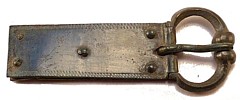 To
the left above, is a 13th century French buckle with rare enamel
detail which was found at the London waterfront. The most famous
factory of that period to produce high-quality, enameled buckles
was in Limoges. To
the left above, is a 13th century French buckle with rare enamel
detail which was found at the London waterfront. The most famous
factory of that period to produce high-quality, enameled buckles
was in Limoges.
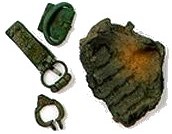 At
right is a buckle from the
Gilbert Collection which was also found in the London
waterfront area. It is of English manufacture and dates to the
14th century. The buckle has a plate with wriggle work decoration
and the rivets remain. The buckle and pin anre unbroken and are
still working. At
right is a buckle from the
Gilbert Collection which was also found in the London
waterfront area. It is of English manufacture and dates to the
14th century. The buckle has a plate with wriggle work decoration
and the rivets remain. The buckle and pin anre unbroken and are
still working.
The buckle mould at left
comes from excavations in York, England, and shows a single loop
buckle with plate- a very popular medieval style, and the most
common in the 14th century. Many buckle plates were gilded, stamped
with decorative features or showed animals and saints.

Belt
Mounts
Leather, woven and fabric belts were often decorated with metal
decorative pieces called mounts. These could be of any design,
although popular motifs included flowers and roses, heraldic devices
and fleur-de-lys.
Shown below is a segment
of a beautiful 14th century belt made from velvet fabric with
extensive metal mounts and decorative metal chape. It is interesting
to note that while some of the mounts appear to be part of a set
design, many of the other mounts do not appear to match anything
at all.

The belt shown below is made from woven silk and has decorative
metal mountings shaped like a rose and a woman's head alternatively
mounted onto it. The belt is believed to be from the 14th century.

Many belt mounts on women's belts were made from silver, although
very often pewter was used to make imitation silver belt mounts.
During the 15th century, pewter belt mounts were widely produced,
especially after the restrictions were lifted.

Belt
hangers- pendant mounts
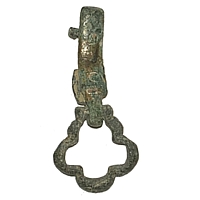 Belts
were not only a fashion accessory, they were also of a far more
practical nature. Belts
were not only a fashion accessory, they were also of a far more
practical nature.
Pockets had yet to a clothing
design element, and the belt was the usual place for a woman to
secure her purse, hang her chest or warderobe keys, her paternoster
or her eating knife. For this she might have used a metal purse
hanger.
The pendant mount, or purse hanger at right comes from the
Gilbert Collection and is dated to the 14th century.
A purse hanger is shown above
on the belt at the top of the page, source unknown, A woman's
purse was usually an ornately embroidered and tasseled affair
and it was as much a fashion accessory as a practical place to
keep money.

Copyright
© Rosalie Gilbert
All text & photographs within this site are the property of
Rosalie Gilbert unless stated.
Art & artifact images remain the property of the owner.
Images and text may not be copied and used without permission.
|